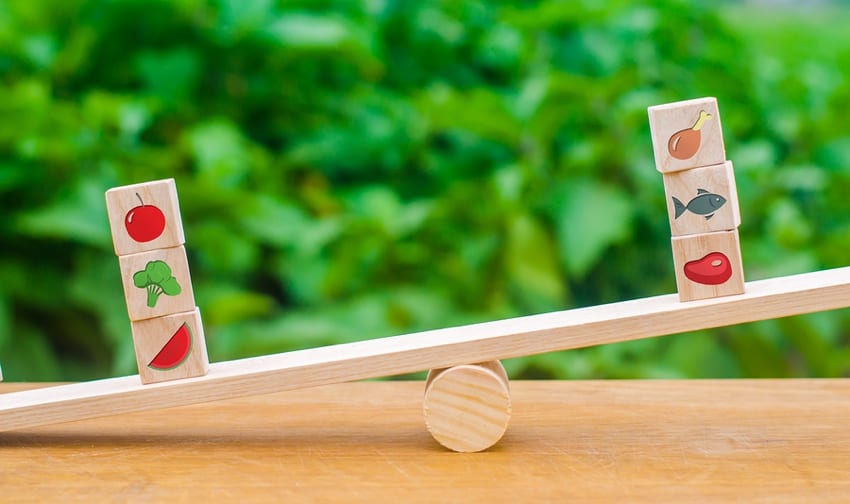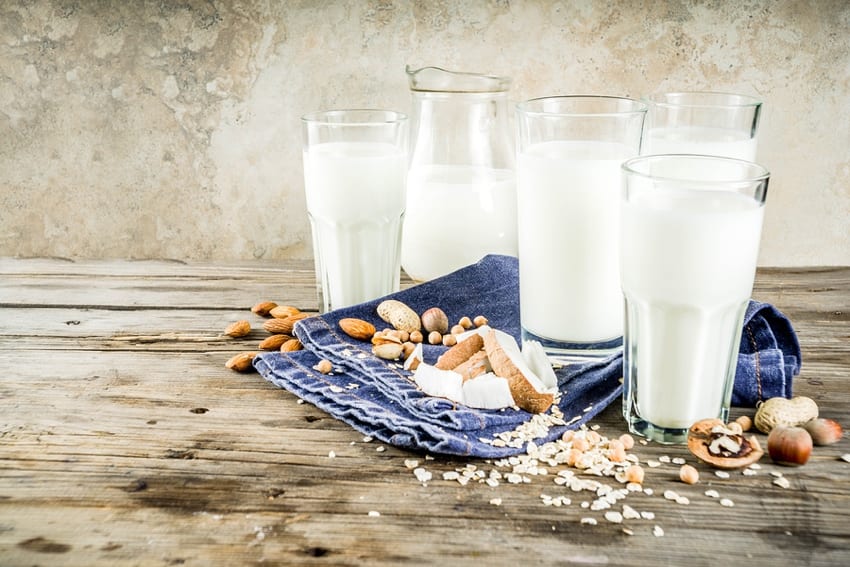 No one said going vegan was easy. But moving from a diet and lifestyle that includes meat and other animal-derived foods and products to a purely plant-based existence need not be overly troublesome. In fact, it can be a rewarding (and even a fun) experience in which you learn about nutrition and discover a wide range of tasty new flavours, foods and recipes.
No one said going vegan was easy. But moving from a diet and lifestyle that includes meat and other animal-derived foods and products to a purely plant-based existence need not be overly troublesome. In fact, it can be a rewarding (and even a fun) experience in which you learn about nutrition and discover a wide range of tasty new flavours, foods and recipes.
For many people, the best way to transition from an omnivorous lifestyle to becoming a vegan is in stages. Which makes sense given that overhauling your whole diet in one fell swoop could prove disruptive and difficult. If you are seeking to go vegan – and to stick at it for the long haul – taking steps in that direction before taking the final plunge seems eminently sensible to us.
How to Go Vegan in 5 Steps

1. Research, Assess & Plan
First things first, take some time – a day or two, a week or a month, it’s up to you – to assess your current diet to find out the kinds of food you are eating and how regularly. Read up about nutrition and how those following a plant-based diet can still allow you to obtain everything you need to be at least as healthy.
The Health & Fitness area of our site can help in this regard as it gives details of good vegan sources of all the main vitamins and nutrients. Then plan your transition to veganism, giving yourself time-specific goals for completing the following steps.
2. Minimise Meat
Once you’ve done a little research, the next step when moving towards veganism is to reduce the meat in your diet as much as you can. Many people find they don’t miss it, and though some prefer going cold turkey (pun intended!) and stopping the consumption of meat in one go, others find it easier to reduce it gradually.
If you fall into the latter category, try only eating meat once or twice a week for a month, then cutting it down from there. There are so many decent vegan meat substitutes that many dishes taste at least as nice without the need to include animal flesh.
3. Farewell Fish
Some people are fine with removing meat from their diet and then settle on a pescatarian diet as a middle-ground option. For those seeking to go vegan though, this isn’t a long-term option. It can be used as a staging post on the journey, but ultimately, vegans can’t eat fish or seafood, so ditching the water-dwellers is a must. As we describe below, this needn’t mean the sacrifice of consuming sufficient levels of protein or even omega-3.
4. Eliminate Eggs & Dairy
Many vegetarians still consume dairy products, but this isn’t an acceptable option for vegans. While there are still not too many fantastic vegan cheeses out there, they are getting better all the time. Thankfully, there are loads of very tasty vegan milk alternatives that make the move away from dairy fairly painless for many people who are choosing to go vegan.
5. Avoid Other Animal Products
This will include foods that might not be quite as obviously non-vegan, such as honey, as well as products derived from animals such as wool and leather. Moving away from foods and looking at the origins of all the products you buy or interact with is the final step in the process of veganism.
This is a stage that many primarily dietary vegans never really embrace fully – simply because to eradicate every product that has been derived from, contains by-products of or has been tested on animals is all but impossible in the UK in modern times. Still, there’s no harming in moving as far as you feel able in that direction.
The 5 Step Process in Greater Detail
Please note that consulting a nutritionist, doctor or other qualified professional can be a good idea before you make major lifestyle changes, especially for people with specific dietary requirements. For most people, understanding the basics of nutrition and the nutritional content of various foods and food groups will allow them to obtain all the essential vitamins and nutrients from a vegan diet.
Breaking down any medium to long term goal – which in this case is to follow a vegan diet and/or lifestyle – into manageable steps can be a great way to achieve that goal. Here we give a little more detail about each of the five steps along with our top tips for ensuring each step is both successful and rewarding.
1. Understand Nutrition, Assess Your Current Diet & Plan the Transition to a Plant-Based Diet

A lot of people in the UK and beyond consume food without much thought about what it is made from or how it is made. With the prevalence of fast food, convenience meals and ultra-processed “food”, this is no surprise.
Researching Nutrition
But it can be quite an eye opener to undertake a little research about the food you eat, allowing you to learn what the mysterious scientific-sounding ingredients and E numbers actually are, and to consider whether these are things you want to actually put in your body.
There are plenty of resources on the Internet to help you assess your current diet, including the Eat Well section of the NHS website and the Association of UK Dietitians, both of which have loads of information about food groups, nutrients and healthy diets.
Keep a Food Diary
Once you have gained at least a basic understanding of nutrition (which you might well already have), assessing your current diet can be a useful process. Keeping a food diary for a week or more can help you identify whether or not you might be consuming less of a particular nutrient than you should, or indeed too much of any particular food group.
Many people are surprised about how many calories and how much sugar and fat they consume. This recognition can help prompt a change towards reducing certain types of food and moving towards a healthier (plant-based) diet.
Set a Timeframe
Giving yourself a timeframe for your transition to veganism can be very useful as you will be able to assess your progress as you go along. For instance, you might set the target of being meat-free by the end of the first month of your journey. This means that you could clearly achieve the goal sooner, but that if you “slip up” at any time within that month, you won’t feel too guilty.
Food guilt is not a great thing at the best of times, and we are all fallible beings, so getting into the habit of not being hard on yourself is a good idea from the start. Contemplating your reasons for choosing to go vegan in the first place, whether health, environmental or ethical, can help keep you on track at this stage.
Tips for Assessing Your Diet & Planning the Transition
In sum, here are our tips for assessing your diet and planning for the transition to Veganism:
- Read Information from Good Nutrition Resources: The NHS, the Association of UK Dietitians and the British Nutrition Foundation are just three of many reliable and scientifically robust sources of information about food and nutrition.
- Keep a Food Diary: There are various apps that can help you track and assess your current eating habits that make it really easy, though some people prefer going old school with a pen and pad of paper.
- Set Time-Specific Goals for Next Steps: Giving yourself sensible time-specific goals for giving up meat, fish and dairy can help you achieve these without too much pressure.
2. Reduce Then Eliminate Meat & Meat Products

Now the planning is over and the action begins. For some people who have chosen to give up meat, the first time they go to a restaurant or to a friend’s barbecue can be challenging to say the least. For others, it can be refreshing and even life-affirming, showing themselves they are in control of what they consume and the choices they make.
Taste Test Vegan Meat Alternatives
Some vegan meat alternatives are better than others, but there are loads of great vegan burgers, sausages and mince alternatives that many people find are at least as flavoursome as the products they seek to replace. As you will see in our vegan barbecue article, there are also some great options that don’t look or taste like meat, but which work very well as alternatives.
Experiment with New Recipes
Most restaurants these days have a number of vegan – or at the very least vegetarian – options on their menus, so eating out shouldn’t cause too much trouble during this stage. In fact, assuming the chefs are good, it can open your taste buds to flavours you might have rarely experienced if you formerly opted for “meat and two veg” style meals, burgers or chicken curries.
Tips for Eliminating Meat
Here are our top tips for reducing then eliminating meat from your diet:
- Start with Mince: Using meat-free mince in dishes, such as spaghetti Bolognese, chilli con “carne” and cottage pie, can often be a great first step in reducing your meat consumption. Chances are, if you are cooking for others, they probably won’t notice it isn’t meat!
- Bangers & Burgers: Sampling a few varieties of meat-free burgers and sausages to find out which are your favourites can be worthwhile and fun. Why not do a taste test among family and friends too?
- Get Imaginative: While plant-based meat alternatives are very good these days, it pays to spread your wings and begin to find some more interesting vegan recipes that could start to replace some of your more common meat dishes. From celeriac steaks to cauliflower curries, there’s a whole world of veg-tastic cuisine awaiting your exploration.
- Take Stock, Celebrate & Prepare for the Next Step: If you complete this stage by eradicating meat from your diet, congratulations! This is the hardest part for many people, so to have got this far means you’ve already achieved something brilliant. Give yourself a pat on the back, have a glass of Champagne… and get ready to say farewell to fish!
3. Eliminate Fish, Seafood & Related Products

In Nirvana’s 1991 song Something in the Way, Kurt Cobain sang, “It’s okay to eat fish ‘cause they don’t have any feelings”. Kurt was undoubtedly a fantastic songwriter, guitarist and (albeit reluctant) frontman of grunge, but when it came to the ability to assess the sentience of aquatic vertebrates, his credentials really must be questioned. There have been numerous scientific research studies in recent years that confirm that fish do indeed possess the ability to feel (including this one about “stress-induced hyperthermia in zebrafish” – a fascinating read).
Irrespective of the scientific literature, being vegan means not eating fish or other water-dwelling creatures belonging to the animal kingdom. This means no cockles, mussels or any other bivalve critters Molly Malone might be selling from her barrow.
Omega-3 Sources & Supplements
The question is, if you have acquired a taste for fish and seafood over the course of your pre-vegan life, how do you go about cutting down and then eliminating such food from your diet? This can be especially tricky for people who consume fish, particularly oily fish, in order to include omega-3 fatty acids in their diet (which are linked to a reduction in the risk of cardiovascular disease).
The good news for vegans or vegans-to-be is that there are plenty of vegan-friendly omega-3 sources that include the likes of linseed oil, linseeds themselves (also called flax seeds) and walnuts. There are also a wide range of vegan omega-3 supplements that many vegans opt to take.
Protein Sources & Supplements
For others, especially pescatarians, fish and seafood can be one of their primary sources of protein. But as we discuss in detail in our vegan protein sources article, there really are loads of good plant-based protein sources.
Some vegans choose to take on extra protein through vegan-friendly protein supplements, but vegans who follow a balanced and well-thought-out diet should be able to obtain all the protein they need without supplements.
Tips for Eliminating Fish & Other Seafood
Here are our top tips for reducing then eliminating fish and seafood from your diet:
- Veggie Fingers Definitely Have No Feelings: As with plant-based alternatives to meat products, there are a growing number of vegan-friendly fish alternatives on the market. These could be the more traditional vegetable fingers that are the shape and appearance of fish fingers, but contain chopped mix veg. But there are an increasing number of “fishless” finger products and similar that profess to have the taste and texture of real fish fingers. Worth a try!
- Mushrooms, Not Mussels: There are so many varieties of mushrooms that offer mind-blowing flavours that work very well as alternatives to mussels and other bivalves. They can soak up flavours very well and have a similar consistency to certain crustaceans.
- Sushi without Fish: Sushi doesn’t need to include fish, and sushi rolls with cucumber, spring onion, avocado or even mango are very tasty, and the nori in which it is wrapped is also a great vegan source of iodine!
4. Replace Dairy Products & Eggs with Vegan Alternatives

How difficult it is to eradicate eggs and dairy products from your diet will clearly depend on how much of the stuff you eat to start with. A good number of people in the UK do without dairy products because of intolerances of some description, and as a result, there are plenty of “free from” products in supermarkets and dairy-free recipes available to accommodate these people and, by extension, vegans.
Milk Alternatives
This means soon-to-be vegans shouldn’t find it too difficult to find vegan-friendly dairy replacements. Certainly this is the case then it comes to vegan milk alternatives, which come in loads of varieties from oat milk to almond milk, cashew to hemp.
Vegan Cheeses
For many vegans, good cheese can be something that is sorely missed. But, thankfully, vegan cheeses have come a long way in recent years and there are various artisan vegan cheese makers and sellers popping up which are well worth sampling.
Say Goodbye to Eggs
For people who are keen on starting the day with a fried or boiled egg, there aren’t many vegan options that will offer a true replication. There are plenty of vegan options to replace eggs as an ingredient in baking and various desserts, but when it comes to eggs themselves, they are just something that vegans have to do without… except Easter eggs, of which there are plenty of vegan-friendly options these days (thank goodness!).
Chocolate
Which links nicely to the usually-dairy product that many people feel they simply could not live without: chocolate. We have sampled far too much vegan chocolate in recent times and, though it varies in quality and taste, the best is as good as the best non-vegan vegan chocolate we’ve sampled. Many of the most popular chocolatiers, including Hotel Chocolat, have a wide range of vegan chocolate products.
Tips for Eliminating Dairy & Eggs
Tips for reducing then eliminating dairy products and eggs from your diet:
- Vegan Milk Alternatives: Sample a few of the vegan-friendly milk alternatives out there and decide which you like. Some people like some varieties (e.g. hazelnut) on breakfast cereals, but feel others (e.g. oat milk) work well in coffee and tea. But other stick to a good all-rounder (e.g. almond milk). The choice is yours, but there are vegan milk alternatives to suit all palates.
- Chickpea Juice: The liquid left behind when you cook chickpeas, and the liquid from a can chickpeas, is called aquafaba. Through some quirk of the universe it actually makes a very good substitute for eggs when making marshmallows, meringues and in baking.
- Vegan Chocolate: Chocolate lovers need not miss out given the number of high quality vegan-friendly chocolate options available. Take time to sample as many of the varieties as you fancy. Then be sure to tell your friends and family when you’ve found your favourite – they’ll be glad of the heads up as people seem to struggle to buy gifts for vegans for some reason.
5. Avoid Other Animal Products – Set Your Own Boundaries

Annoyingly, there are many things that people might not realise contain animal products or that have used animal products in their production.
Beer & Wine
Even more annoyingly, this includes many varieties of beer. But these days, drinks brands have cottoned onto the fact that using the swim bladders of fish to filter beer is not only disgusting, it also means vegans are not likely to buy their product.
The potential for being non-vegan is also true of wine, snacks and basically any food stuff that has been processed in any way prior to it making onto the shelves. Doing a bit of reading about your favourite brands, their ingredients and the production processes that have been employed, or contacting the manufacturer, can help you learn which products are vegan friendly and which should be avoided.
Exceptions to the Rule
There are exceptions to every rule and there are some things that have been derived from or tested on animals that it is definitely not advisable to avoid, i.e. medicines & vaccinations. There is surely no point having an ethical stance if that ethical stance causes you to become seriously ill, or even to die. Animals aren’t going to thank you for that.
Household Goods, Clothing, Etc.
There are, however, plenty of household goods, articles of clothing and other products that have used animals in some way that it isn’t too difficult to avoid these days. Though some people cannot get their head around the reasons wool isn’t vegan, essentially anything that exploits animals to benefit humans will not comfortably fit within the vegan lifestyle. There are so many very good vegan alternatives to wool available from ethical clothing companies, including cotton, linen, hemp and jute, that most vegans don’t have difficulty avoiding the purchase of new woolly jumpers.
Many vegans choose to keep making use of non-vegan products they already own, including woolly jumpers, leather belts or whatever, on the basis that simply throwing them out would not be good for the environment. Others might choose to instead give them to charity shops.
Your Small Changes Benefit the Environment!
Given that the ethos of veganism also promotes reducing environmental harm, this stage of going vegan can also include actions or decisions that are like to benefit the environment (and hence not have a negative effect on animals and humans in general).
Reducing the use or purchase of single-use plastics, products containing or made with potentially hazardous chemicals, and taking account of the water footprint and food miles of the food and products you buy can be time-consuming, but many vegans opt to make as many ethically-sound purchasing decisions as possible.
Tips for Eliminating Other Animal-Derived Products
In summary, here are our tips for reducing the use of other animal-derived products from your life:
- Don’t Stress: The key to this step of going vegan is to avoid stressing too much. To have gotten this far means you’ve already made a massive positive step towards helping animals and the environment (and quite probably your health). So, if you are on a night out and you happen to have a pint of beer that you haven’t triple-checked is definitely vegan, it’s really not the end of the world.
- When Possible & Practicable: The definition of veganism includes the term “as far as is possible and practicable” in relation to avoiding animal products. Bear this in mind and refer back to the last point: don’t stress.
- Remind Yourself Why: Regularly reminding yourself why you have chosen to go vegan in the first place can be a powerful way to encourage yourself to continue on the journey. Giving yourself (vegan-friendly!) rewards for hitting certain milestones (three months, six month, a year and so on) might also help maintain veganism.
Steps to Going Vegan: Conclusion
Whether you are going vegan for health reasons or you are focussed on the ethical arguments for veganism, as long as you access the plentiful information available, there is no reason why you can’t enjoy a vegan lifestyle that is full of fantastic food that also benefits the environment, not to mention animals themselves.
Remembering that any steps towards veganism are likely to have benefits for the environment, your health and, not least, the lives of the animals that you won’t be eating, even if you don’t end up going full vegan, you are still on a positive path.